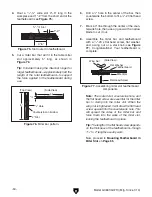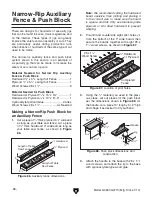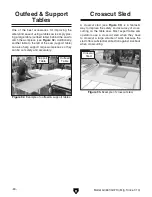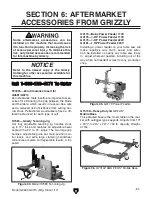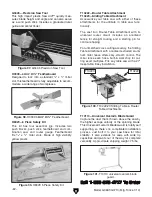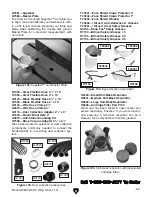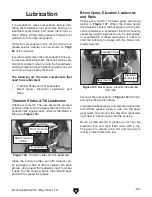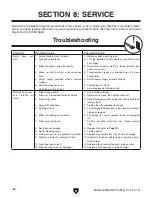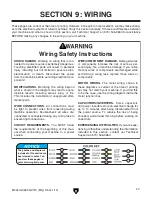
Model g0661/g0713 (Mfg. since 1/10)
-67-
symptom
possible Cause
possible solution
handwheel binds or
is difficult to move.
1. lock knob is engaged.
2. handwheel shaft pins are wedged.
3. handwheel is inserted too far.
4. too much engagement between the worm
gear & trunnion
1. loosen lock knob.
2. remove handwheel and adjust shaft pins.
3. remove handwheel and adjust key.
4. adjust worm gear engagement.
Blade does not
reach 90 degrees.
1. pointer or scale calibrated incorrectly.
2. 90 degree stop bolt is out of adjustment.
1. Calibrate pointer/scale at true 90 degrees (
page
68).
2. adjust 90 degree stop bolt (
page 68).
Blade does not
reach 45 degrees.
1. 45 degree stop bolt is out of adjustment.
2. sawdust is built up in front trunnion.
1. adjust 45 degree stop bolt (
page 69).
2. Check for sawdust in trunnions, clean and re-lubri-
cate as necessary.
Blade too close to
insert.
1. Blade position on arbor is incorrect.
2. table mounting position is not centered.
1. Verify that blade arbor washers are correct and in
the required position.
2. loosen table mounting bolts, adjust table position,
then realign the blade.
Blade will not go
beneath table sur-
face.
1. handwheel shaft pins are wedged.
2. roll pin/setscrew in worm gear contacting
geared trunnion.
3. handwheel key is inserted too far.
1. remove handwheel and adjust shaft pins.
2. tighten roll pins and setscrews in the worm gear.
3. remove handwheel and adjust key.
Blade will not move
up or down.
1. set screw on worm gear is loose/missing.
2. handwheel shaft key is missing.
1. tighten or replace set screw.
2. replace key.
Workpiece burns or
binds when feeding.
1. riving knife not correctly aligned with
blade.
2. spreader not correctly aligned with blade.
3. Fence not parallel with blade (pressure at
blade backside).
4. Blade is warped or damaged.
5. too many teeth on blade for cutting type.
1. adjust riving knife into alignment with blade (
page
71).
2. adjust spreader into alignment with blade (
page
71).
3. adjust fence parallel with blade (
page 73).
4. replace blade (
page 36).
5. Change blade to one with fewer teeth.
too much sawdust
blown back toward
operator.
1. Blade guard has been removed.
2. too many air leaks in cabinet for proper
dust collection.
3. dust collection system clogged; too weak.
4. Fence not parallel with blade (pressure at
blade backside).
5. Miter slot/fence not parallel with blade at
90°.
1. re-install blade guard for maximum safety and dust
control.
2. seal leaks in cabinet or around dust chute.
3. remove clog; revise ducting layout for improved
suction.
4. adjust fence parallel with blade (
page 73).
5. adjust table so miter slot is parallel with blade at 90°
(
page 69).


